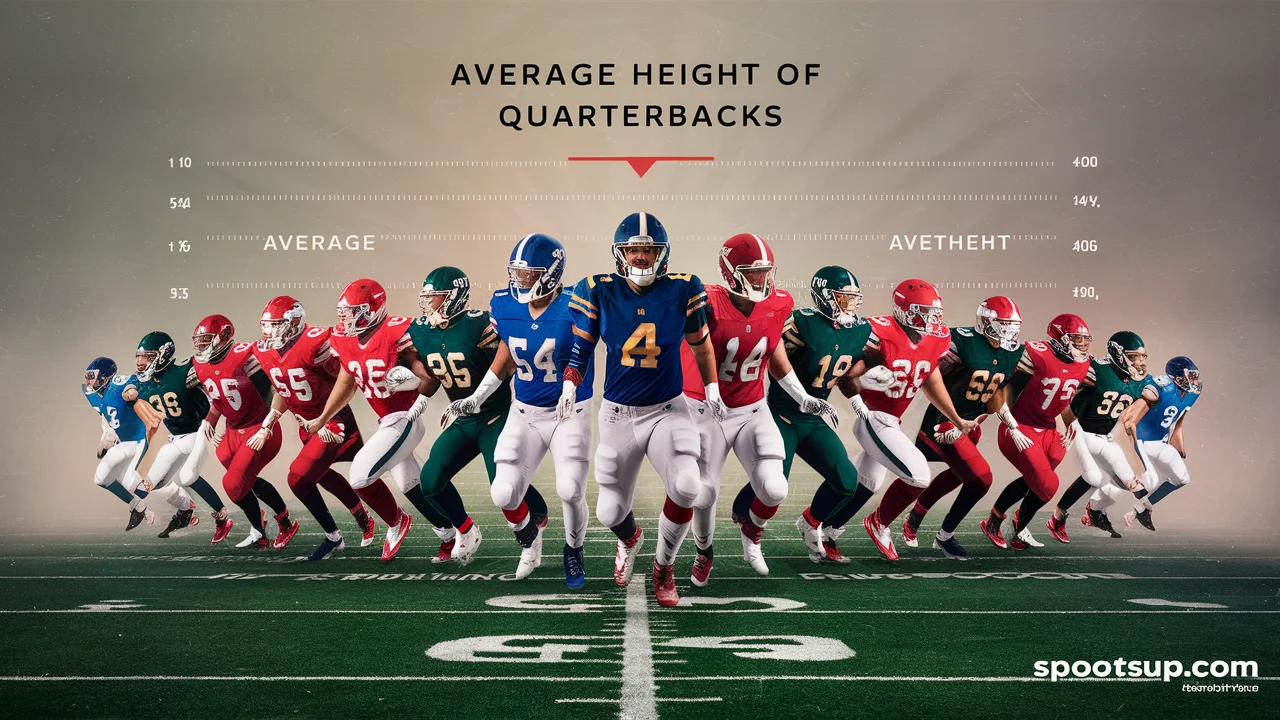The height of NFL quarterbacks has always been a topic of fascination and debate among fans and analysts alike. In 2024, the average height of NFL quarterbacks continues to be a key point of discussion as it significantly impacts gameplay and team strategy. This article delves into the current quarterback height statistics, offering insights into how height trends have evolved and what they mean for the sport today.
- Current Stats: Discover the latest average heights and compare them with historical data.
- Impact on Performance: Learn how a quarterback’s height can influence their on-field effectiveness.
- Future Predictions: Explore how trends might shift and what that could mean for future NFL drafts.
Join us as we explore the dynamic world of NFL quarterback height, its historical context, and its impact on the game in 2024.
1. Historical Context of Quarterback Height 📜
Understanding the historical context of quarterback height provides valuable insights into how the role and expectations for NFL quarterbacks have evolved over time. From the early days of the NFL to the present, quarterback height has undergone significant changes, reflecting shifts in playing style, team strategies, and scouting preferences.
- Early NFL Quarterbacks: In the early days of the league, quarterbacks were generally shorter by today’s standards. Players like Sammy Baugh, who stood around 6 feet tall, were considered towering figures of their time. The focus was more on strategy and less on physical attributes.
- 1970s and 1980s: During these decades, the average height of quarterbacks began to increase slightly as the game became more competitive and physically demanding. Quarterbacks like Joe Montana (6 feet 2 inches) became prominent, demonstrating that height could be an asset.
- 1990s and 2000s: The 1990s and early 2000s saw a further rise in average quarterback height. Iconic figures such as Peyton Manning (6 feet 5 inches) and Tom Brady (6 feet 4 inches) set new benchmarks. The trend towards taller quarterbacks was driven by the need for improved visibility and arm strength.
- Recent Trends: In the last decade, the trend towards taller quarterbacks has continued, with many teams now preferring quarterbacks over 6 feet 3 inches. This shift reflects the importance of height in modern offensive schemes and the increased physical demands of the game.
- Notable Historical Figures: Examining quarterbacks like Johnny Unitas and Dan Marino reveals how height influenced their playing style and success. Their careers highlight how height has played a role in shaping the expectations and performance of NFL quarterbacks.
The evolution of quarterback height not only reflects changes in the game’s physical demands but also underscores the shifting strategies and scouting philosophies of NFL teams. As we move into 2024, these historical insights help us understand the current trends and their implications for the future.
2. Average Height of NFL Quarterbacks in 2024 📏
As we dive into the average height of NFL quarterbacks in 2024, it’s important to understand how this metric reflects current trends and influences player performance. This section provides a detailed look at the current statistics and how they compare to historical data, shedding light on the significance of quarterback height in today’s game.
- Current Statistics: In 2024, the average height of NFL quarterbacks is approximately 6 feet 4 inches. This height has become somewhat of a standard, reflecting the modern preference for taller quarterbacks who offer both visibility and physical presence on the field.
- Comparison with Previous Years: When compared to previous decades, this average height marks a notable increase. For instance, in the early 2000s, the average height was closer to 6 feet 3 inches. The shift towards taller quarterbacks highlights a growing trend towards prioritizing height in player evaluations.
- Top 5 Tallest Quarterbacks:
- Justin Herbert (6 feet 6 inches): Known for his impressive arm strength and visibility over the offensive line.
- Josh Allen (6 feet 5 inches): Combines height with mobility, making him a dual-threat quarterback.
- Trevor Lawrence (6 feet 6 inches): Offers a commanding presence and strong passing ability.
- Matthew Stafford (6 feet 3 inches): Veteran quarterback known for his powerful throws and leadership.
- Joe Burrow (6 feet 4 inches): Displays a blend of height and agility, contributing to his success.
- Top 5 Shortest Quarterbacks:
- Kyler Murray (5 feet 10 inches): Despite his height, he has excelled with quickness and agility.
- Drew Brees (6 feet): A notable example of a shorter quarterback who achieved great success.
- Russell Wilson (5 feet 11 inches): Known for his mobility and ability to make plays outside the pocket.
- Baker Mayfield (6 feet 1 inch): Combines height with a strong arm and competitive nature.
- Tua Tagovailoa (6 feet 1 inch): Demonstrates accuracy and decision-making skills despite his height.
- Factors Influencing Height Trends: The preference for taller quarterbacks can be attributed to several factors, including the need for better visibility over the offensive line, the ability to make longer throws, and the physical demands of modern football. Teams are increasingly valuing quarterbacks who can maintain durability and withstand physical challenges.
Understanding the average height of NFL quarterbacks in 2024 provides a clear picture of how the role has evolved and highlights the continuing importance of height in player evaluations. As teams look for the next generation of quarterbacks, these trends will play a crucial role in shaping future draft choices and team strategies.
3. Impact of Height on Performance 📊
The height of a quarterback can significantly influence their performance on the field. Understanding how a quarterback’s height affects their gameplay is crucial for analyzing current trends and evaluating player effectiveness. This section explores the advantages and challenges associated with different quarterback heights and provides case studies to illustrate these impacts.
- Physical Advantages:
- Visibility: Taller quarterbacks generally have a better view over the offensive line, which helps them see open receivers and make accurate throws. This advantage is particularly noticeable in passing plays where visibility is crucial.
- Throwing Angles: Height allows quarterbacks to have a higher release point, reducing the likelihood of their passes being deflected by defensive linemen. This advantage can result in more effective deep throws and fewer intercepted passes.
- Durability: Taller quarterbacks often have a stronger physical presence, which can contribute to their ability to withstand hits and injuries. Their size can also aid in maintaining durability throughout a demanding season.
- Challenges:
- Mobility: While height can be beneficial, it can also limit a quarterback’s mobility. Taller quarterbacks may find it more difficult to evade pressure and scramble effectively compared to shorter, more agile quarterbacks.
- Balance and Footwork: Maintaining balance and executing quick footwork can be challenging for taller quarterbacks. Their increased height may impact their stability and ability to make precise movements under pressure.
- Lower Center of Gravity: Shorter quarterbacks often have a lower center of gravity, which can enhance their balance and agility. This can be an advantage in situations requiring quick changes in direction and evading defenders.
- Case Studies:
- Successful Tall Quarterbacks:
- Tom Brady (6 feet 4 inches): Despite his height, Brady has excelled with a combination of accuracy, decision-making, and leadership. His height provides him with a clear view of the field and contributes to his success in the pocket.
- Peyton Manning (6 feet 5 inches): Manning’s height allowed him to effectively manage the game and execute complex plays. His physical presence and throwing mechanics contributed to his prolific career.
- Successful Shorter Quarterbacks:
- Russell Wilson (5 feet 11 inches): Wilson’s height does not hinder his success; instead, his agility and quick release make him a dynamic playmaker. His ability to move outside the pocket and create plays is a testament to his skill.
- Drew Brees (6 feet): Brees demonstrated that height is not the sole determinant of success. His accuracy, quick decision-making, and leadership allowed him to become one of the NFL’s most prolific passers.
- Successful Tall Quarterbacks:
- Overall Impact: The impact of height on quarterback performance varies depending on individual skills and playing style. While taller quarterbacks benefit from improved visibility and durability, shorter quarterbacks often excel in mobility and quickness. Teams must weigh these factors when evaluating and selecting quarterbacks to fit their specific needs and strategies.
Understanding the impact of height on quarterback performance provides a deeper appreciation of the factors influencing gameplay and helps in evaluating the strengths and weaknesses of different quarterbacks. This knowledge is crucial for teams, analysts, and fans alike as they assess the effectiveness of quarterbacks and their contributions to the game.
4. Trends in Quarterback Selection 📈
The selection of NFL quarterbacks has evolved significantly over the years, with height becoming a more prominent factor in the scouting and drafting process. This section explores the current trends in quarterback selection, including how teams prioritize height, the preferences of various teams, and how these trends have shifted over time.
- Scouting Trends:
- Height as a Key Factor: In recent years, NFL teams have increasingly valued taller quarterbacks. This trend is driven by the advantages that height provides, such as improved visibility and a higher throwing release point. Scouting reports now place a strong emphasis on height as a critical criterion for evaluating quarterback prospects.
- Data-Driven Decisions: Teams use advanced analytics and data to assess the performance of quarterbacks based on height and other physical attributes. This data helps teams make informed decisions during the draft and player evaluations, leading to a greater focus on height in the selection process.
- Shift in Priorities: While height has always been a consideration, the growing emphasis on it reflects changes in offensive strategies and the increasing physical demands of the game. Teams are looking for quarterbacks who can meet these evolving requirements and provide a competitive edge.
- Team Preferences:
- Teams Favoring Taller Quarterbacks: Some teams have a clear preference for taller quarterbacks, believing that height contributes to success. For example, teams with a traditional pocket-passing offense often prioritize quarterbacks who are 6 feet 4 inches or taller, as they offer a better view over the offensive line and can make deeper throws.
- Teams Embracing Mobility: Conversely, teams with a more dynamic offensive approach may prioritize other attributes over height. Teams that utilize a mobile quarterback or a spread offense might be more open to shorter quarterbacks who excel in agility and quick decision-making.
- Balancing Height with Other Skills: Many teams seek a balance between height and other important skills, such as accuracy, leadership, and decision-making. While height is a significant factor, it is not the sole determinant of a quarterback’s potential success.
- Changes in Trend:
- Historical Preferences: Historically, shorter quarterbacks were more common, with many successful players standing under 6 feet 2 inches. However, as the game has evolved, the average height of quarterbacks has increased, reflecting changes in playing style and team strategies.
- Current Observations: In the 2024 draft and recruitment process, teams are continuing to favor taller quarterbacks, though there remains a place for shorter players who possess exceptional skills. This trend indicates that while height is important, teams are increasingly recognizing the value of a diverse skill set.
- Future Predictions: Looking ahead, it is likely that the emphasis on quarterback height will continue to shape the selection process. However, teams may also place greater importance on adaptability and the ability to fit into specific offensive schemes, potentially leading to a more nuanced approach to quarterback evaluations.
Understanding the trends in quarterback selection provides insight into how teams make strategic decisions and prioritize attributes like height. By analyzing these trends, fans and analysts can better appreciate the factors influencing the draft and player evaluations, as well as the evolving nature of the quarterback position in the NFL.
5. Impact of Height on Playing Style and Strategy 🏆
The height of a quarterback plays a crucial role in shaping their playing style and influencing the strategies used by their team. This section explores how different heights affect quarterback play and the corresponding adjustments in offensive strategies and defensive approaches.
- Play Styles:
- Tall Quarterbacks: Taller quarterbacks, typically over 6 feet 4 inches, are often favored for their ability to make deep throws and see over the offensive line. They excel in traditional pocket-passing roles, where their height helps them deliver accurate passes from a stationary position. Their physical presence allows them to withstand pressure and deliver strong throws downfield.
- Shorter Quarterbacks: Shorter quarterbacks, generally under 6 feet 1 inch, often rely on their agility and quickness to create plays. They excel in roles that require mobility, such as scrambling or extending plays outside the pocket. Their lower center of gravity can enhance their balance and ability to evade defenders, making them effective in dynamic offensive schemes.
- Offensive Schemes:
- Traditional Pocket-Passing Offense: Teams that favor a traditional pocket-passing offense often prioritize taller quarterbacks. The height allows these quarterbacks to survey the field more effectively and make precise throws over defenders. Offensive line protection is crucial, as these quarterbacks typically operate from a stationary position within the pocket.
- Spread and RPO Offenses: Teams using spread offenses or run-pass options (RPO) may prefer quarterbacks who are more mobile and adaptable. Shorter quarterbacks often fit well in these systems, as they can quickly make decisions and execute plays on the run. The emphasis is on agility and quick thinking rather than just height.
- Defensive Challenges:
- Defending Against Tall Quarterbacks: Defenders often face challenges when playing against tall quarterbacks, as their height provides a better vantage point and a higher release point for passes. Defensive lines and pass rushers may need to employ strategies to disrupt the quarterback’s view and timing, such as increased pressure or targeting the quarterback’s lower body.
- Defending Against Shorter Quarterbacks: Shorter quarterbacks present different challenges for defenses. Their mobility and quick release can make it difficult for defenders to predict their movements and timing. Defenses may need to adjust their approach by focusing on containing the quarterback and limiting their ability to extend plays.
- Case Studies:
- Successful Tall Quarterbacks:
- Aaron Rodgers (6 feet 2 inches): Rodgers uses his height to deliver precise passes and manage the pocket effectively. His ability to read defenses and make quick decisions has contributed to his success in a traditional offensive scheme.
- Ben Roethlisberger (6 feet 5 inches): Roethlisberger’s height and strength allow him to withstand pressure and make powerful throws. His playing style is well-suited to a conventional pocket-passing offense.
- Successful Shorter Quarterbacks:
- Kyler Murray (5 feet 10 inches): Murray’s agility and quickness make him a dynamic playmaker. He excels in systems that leverage his mobility and ability to make plays on the move.
- Drew Brees (6 feet): Brees demonstrates that a shorter quarterback can succeed with accuracy and quick decision-making. His playing style adapts well to a pass-oriented offense with quick releases.
- Successful Tall Quarterbacks:
Understanding the impact of height on playing style and strategy provides valuable insights into how quarterbacks influence offensive and defensive tactics. By examining how different heights affect gameplay, teams can better tailor their strategies and player evaluations to optimize performance and achieve success on the field.
6. Future Predictions for Quarterback Height Trends 🔮
As the NFL continues to evolve, so do the trends in quarterback height. This section explores predictions for how quarterback height may change in the coming years, considering technological advancements, evolving playing styles, and emerging talent.
- Technological and Training Advances:
- Improved Scouting Tools: Advances in scouting technology and data analytics are likely to refine the evaluation of quarterback height and its impact on performance. Enhanced measurement tools and performance metrics will provide more precise insights into how height influences a quarterback’s effectiveness.
- Training Techniques: As training techniques continue to advance, teams may focus more on developing quarterbacks’ physical attributes and skills regardless of height. This could lead to a more diverse range of successful quarterbacks, potentially shifting the emphasis away from height alone.
- Evolving Playing Styles:
- Increased Mobility: The trend towards mobile quarterbacks is likely to continue, as modern offenses increasingly prioritize agility and the ability to extend plays. While height will still be a factor, teams may place greater emphasis on a quarterback’s mobility and adaptability to fit new offensive schemes.
- Hybrid Roles: We may see more hybrid roles where quarterbacks combine traditional pocket-passing skills with mobility. This could lead to a blending of height preferences, as teams seek quarterbacks who can effectively perform in various playing styles.
- Emerging Talent:
- Diverse Skill Sets: The next generation of quarterbacks is likely to bring a diverse range of skills and attributes. Height will still play a role, but emerging talent may challenge traditional preferences by showcasing success across different physical profiles.
- Global Influence: As the NFL continues to expand its global reach, we may see more international players entering the league with varying heights and playing styles. This could introduce new dynamics and trends in quarterback selection.
- Potential Shifts:
- Greater Emphasis on Skill: While height will remain an important factor, teams may increasingly prioritize a quarterback’s overall skill set and performance metrics. This shift could lead to a more nuanced approach to player evaluation, where height is considered alongside other critical attributes.
- Adaptation to Defensive Strategies: As defensive strategies evolve, the need for quarterbacks to adapt may influence height trends. Teams may seek quarterbacks who can effectively counter new defensive schemes, potentially altering preferences for height and other physical attributes.
- Long-Term Predictions:
- Balanced Approach: The future may see a balanced approach where height is one of many factors considered in quarterback evaluations. Teams will likely continue to weigh height alongside other skills, performance metrics, and adaptability.
- Innovative Offenses: The development of innovative offensive strategies could influence quarterback height trends. Teams may design offenses that cater to different quarterback profiles, leading to a more diverse range of successful players.
Understanding the future predictions for quarterback height trends provides insight into how the NFL may evolve and how teams will adapt their strategies and evaluations. By anticipating these changes, fans and analysts can better grasp the factors that will shape the quarterback position in the coming years and appreciate the dynamic nature of the game.
7. Notable Quarterbacks and Their Heights 🌟
Examining notable quarterbacks and their heights offers valuable insights into how different physical profiles have succeeded in the NFL. This section highlights a selection of prominent quarterbacks, showcasing how their height has influenced their careers and contributions to the game.
- Tall Quarterbacks:
- Tom Brady (6 feet 4 inches): Known for his exceptional career, Brady’s height has contributed to his ability to oversee the field and make precise throws. His success with the New England Patriots and Tampa Bay Buccaneers illustrates how a taller quarterback can excel in a traditional pocket-passing role.
- Peyton Manning (6 feet 5 inches): Manning’s height allowed him to manage the game effectively and execute complex offensive plays. His career with the Indianapolis Colts and Denver Broncos highlights how height can enhance a quarterback’s effectiveness in leading an offense.
- Ben Roethlisberger (6 feet 5 inches): Roethlisberger’s height, combined with his strength, has enabled him to withstand pressure and make powerful throws. His success with the Pittsburgh Steelers demonstrates how height can contribute to durability and performance.
- Average Height Quarterbacks:
- Aaron Rodgers (6 feet 2 inches): Rodgers’ height, though slightly below the tallest quarterbacks, has not hindered his success. His ability to read defenses, make accurate throws, and manage the game exemplifies how a slightly shorter quarterback can still thrive in a traditional pocket role.
- Matt Ryan (6 feet 4 inches): Ryan’s height and precision have made him a successful quarterback for the Atlanta Falcons and Indianapolis Colts. His playing style combines height with accuracy and leadership, contributing to his effectiveness.
- Shorter Quarterbacks:
- Russell Wilson (5 feet 11 inches): Despite being shorter than many of his peers, Wilson’s agility and quick release have made him a dynamic playmaker. His success with the Seattle Seahawks and Denver Broncos showcases how height can be offset by mobility and skill.
- Kyler Murray (5 feet 10 inches): Murray’s height has not impeded his success; instead, his quickness and ability to extend plays make him a valuable asset. His performance with the Arizona Cardinals demonstrates that height is not the sole determinant of a quarterback’s effectiveness.
- Historical Influences:
- Johnny Unitas (6 feet 1 inch): Unitas’ height was considered impressive during his era, and his success with the Baltimore Colts helped shape the expectations for future quarterbacks. His career underscores the impact of height in different historical contexts.
- Drew Brees (6 feet): Brees, known for his accuracy and leadership, proved that a shorter quarterback can achieve greatness. His career with the New Orleans Saints illustrates how skills and attributes other than height can lead to success.
- Impact on Position Evolution:
- Changing Standards: The careers of these quarterbacks reflect how the standards for height have evolved over time. As the game has developed, the expectations for quarterback height have shifted, influencing how players are evaluated and selected.
Examining the notable quarterbacks and their heights provides a comprehensive view of how different physical profiles have succeeded in the NFL. By exploring these examples, we gain insights into how height interacts with other skills and attributes to shape a quarterback’s career and impact the game.
8. Comparing Quarterback Height Across the NFL 🏈
To understand how quarterback height varies within the NFL, it’s essential to examine the differences between quarterbacks of various heights and how these differences impact their roles and success. This section compares quarterbacks based on their height, analyzing how height influences their performance and their team’s strategy.
- Height Distribution:
- Tall Quarterbacks:
- Average Height: Typically over 6 feet 4 inches. These quarterbacks are often favored for their ability to make deep throws and see over the offensive line.
- Examples:
- Tom Brady (6 feet 4 inches): Known for his precision and leadership, Brady’s height contributes to his effectiveness in a traditional pocket role.
- Peyton Manning (6 feet 5 inches): His height aids in delivering accurate passes and managing the game effectively.
- Average Height Quarterbacks:
- Average Height: Between 6 feet 1 inch and 6 feet 3 inches. These quarterbacks strike a balance between height advantages and mobility.
- Examples:
- Aaron Rodgers (6 feet 2 inches): Combines height with agility and quick decision-making, demonstrating how height and skill can complement each other.
- Matt Ryan (6 feet 4 inches): Uses his height for accuracy and leadership while maintaining a solid playing style.
- Shorter Quarterbacks:
- Average Height: Under 6 feet 1 inch. These quarterbacks often excel in mobility and quickness, making them effective in dynamic offensive schemes.
- Examples:
- Russell Wilson (5 feet 11 inches): His agility and ability to extend plays highlight how shorter quarterbacks can be successful with the right skill set.
- Kyler Murray (5 feet 10 inches): Demonstrates that height is not the only factor for success; quickness and adaptability are key.
- Tall Quarterbacks:
- Performance Analysis:
- Tall Quarterbacks:
- Strengths: Better visibility over the offensive line, higher throwing release point, and improved durability. These attributes contribute to effective long throws and overall game management.
- Weaknesses: May face challenges with mobility and quick footwork. Taller quarterbacks might struggle to evade pressure and perform quick lateral movements.
- Average Height Quarterbacks:
- Strengths: Balances height advantages with agility and quick decision-making. This blend allows for effective traditional passing and adaptability in dynamic offenses.
- Weaknesses: Might not have the same level of height-related benefits as taller quarterbacks but can still excel with a well-rounded skill set.
- Shorter Quarterbacks:
- Strengths: Exceptional mobility, quick release, and agility. These quarterbacks are often effective in spread offenses and can evade pressure more effectively.
- Weaknesses: Limited visibility and potentially lower throwing release point. They may face challenges against taller defensive players who can disrupt passing lanes.
- Tall Quarterbacks:
- Team Strategies:
- Teams with Tall Quarterbacks: Often prioritize a traditional pocket-passing approach, relying on height for deep throws and managing the game from within the pocket. Offensive line protection is crucial to maximize the quarterback’s effectiveness.
- Teams with Average Height Quarterbacks: May use a balanced approach, combining traditional passing with elements of mobility and quick decision-making. This versatility allows for adaptability to different game situations.
- Teams with Shorter Quarterbacks: Typically emphasize mobility and dynamic offensive schemes, such as read-option or spread offenses. These teams design plays to capitalize on the quarterback’s agility and quickness.
Comparing quarterback height across the NFL provides a clearer understanding of how different physical profiles influence performance and team strategies. By examining these variations, we gain insights into how height interacts with other attributes and how teams tailor their approaches to maximize their quarterbacks’ effectiveness.
9. Impact of Height on Career Longevity and Injuries 🏥
The height of a quarterback can significantly influence their career longevity and susceptibility to injuries. This section delves into how different heights impact a quarterback’s durability, the types of injuries they may face, and strategies to mitigate these risks.
- Injury Risks by Height:
- Tall Quarterbacks:
- Potential Injuries: Taller quarterbacks often face injury risks related to their physical stature, such as back problems, shoulder issues, and knee injuries. The stress on their bodies from taking hits and the physical demands of the position can lead to long-term health concerns.
- Impact of Height: The increased height can put additional strain on the spine and joints. Tall quarterbacks might experience more wear and tear due to the high-impact nature of the game and the physicality of defensive players targeting them.
- Examples:
- Ben Roethlisberger: Despite his successful career, Roethlisberger has faced various injuries, including shoulder and knee issues, partly due to his height and playing style.
- Average Height Quarterbacks:
- Injury Risks: Average-height quarterbacks may experience fewer issues related to their stature but are still vulnerable to common quarterback injuries like concussions, shoulder strains, and leg injuries.
- Impact of Height: Their height often provides a balance between visibility and mobility, which can help reduce the impact of injuries related to physical stress. However, they are not immune to the general risks associated with the position.
- Examples:
- Aaron Rodgers: While Rodgers has faced injuries, such as a broken collarbone, his height provides a balance that helps mitigate some of the risks associated with the quarterback position.
- Shorter Quarterbacks:
- Potential Injuries: Shorter quarterbacks may face different injury risks, such as increased vulnerability to hits and potential strain from more dynamic movements. Their lower stature might make them more susceptible to certain types of tackles and impacts.
- Impact of Height: The lower center of gravity can offer some advantages in terms of balance and evasion, but shorter quarterbacks might experience increased wear and tear due to their constant movement and the need to evade pressure.
- Examples:
- Russell Wilson: Despite his agility and mobility, Wilson has faced injuries such as ankle sprains and finger issues, which can be attributed to the physical demands and dynamic nature of his playing style.
- Tall Quarterbacks:
- Strategies for Longevity:
- Training and Conditioning: Regardless of height, effective training and conditioning are crucial for maintaining a quarterback’s durability. Strength training, flexibility exercises, and injury prevention routines help mitigate risks and enhance overall resilience.
- Protective Gear: Using high-quality protective gear, including well-fitted pads and helmets, is essential for all quarterbacks. Advances in equipment technology can help reduce the impact of collisions and protect against injuries.
- Playing Style Adjustments: Adjusting playing style to minimize exposure to hits can help improve career longevity. For taller quarterbacks, this might involve optimizing pocket movement and improving offensive line protection. For shorter quarterbacks, focusing on quick decision-making and effective evasion can reduce injury risk.
- Career Longevity:
- Factors Influencing Longevity: Various factors, including height, playing style, and overall physical condition, impact a quarterback’s career longevity. While height can influence injury risks, a combination of effective management, conditioning, and playing strategy plays a significant role in extending a quarterback’s career.
- Examples of Longevity:
- Tom Brady: Despite being a taller quarterback, Brady’s career longevity is attributed to his disciplined training, conditioning, and effective injury management.
- Drew Brees: Brees, as a shorter quarterback, has demonstrated career longevity through careful management of his body and playing style.
Understanding the impact of height on career longevity and injuries provides valuable insights into how different physical profiles affect a quarterback’s health and durability. By exploring these factors, we gain a deeper appreciation of the challenges quarterbacks face and the strategies employed to ensure their long-term success and well-being.
10. Analyzing Height Trends in Recent NFL Drafts 📈
Examining height trends in recent NFL drafts offers insights into how teams are evaluating quarterbacks and how these trends reflect changes in the game. This section explores the data on quarterback heights from recent drafts and analyzes the implications for future evaluations and selections.
- Draft Trends:
- Height Data Analysis: Over the past few years, the height of drafted quarterbacks has shown a range of trends. Teams have varied in their preference for taller versus shorter quarterbacks, influenced by changing offensive strategies and evolving player profiles.
- Tall Quarterbacks: Recent drafts have seen a number of taller quarterbacks being selected, reflecting a continued preference for height in traditional pocket-passing roles.
- Shorter Quarterbacks: At the same time, there has been a growing acceptance of shorter quarterbacks, particularly those with exceptional mobility and skill sets that fit modern offensive schemes.
- Historical Comparison:
- Past Trends: Historically, taller quarterbacks were often favored, with a general expectation that height was a key attribute for success. This trend has evolved, with more emphasis now placed on overall skill and adaptability.
- Recent Shifts: Recent drafts show a more balanced approach, where height is considered alongside other factors such as agility, arm strength, and decision-making. This shift reflects the changing nature of the quarterback position and the variety of successful playing styles.
- Height Data Analysis: Over the past few years, the height of drafted quarterbacks has shown a range of trends. Teams have varied in their preference for taller versus shorter quarterbacks, influenced by changing offensive strategies and evolving player profiles.
- Impact of Offensive Schemes:
- Traditional Offenses: Teams favoring traditional pocket-passing schemes continue to prioritize taller quarterbacks, valuing their ability to manage the game from a stationary position and make deep throws.
- Modern Offenses: The rise of spread and read-option offenses has increased the demand for quarterbacks who can move effectively and make plays on the run. This has led to a more diverse range of heights being considered in recent drafts.
- Evaluating Draft Prospects:
- Scouting Reports: Scouting reports from recent drafts indicate a nuanced evaluation process where height is one of many factors considered. Teams assess quarterbacks based on their overall skill set, including mobility, accuracy, and leadership qualities.
- Performance Metrics: Teams use a combination of performance metrics, including height, to evaluate quarterback prospects. Data on throwing accuracy, decision-making, and physical attributes helps inform draft selections.
- Notable Draft Picks:
- Recent Tall Picks: Examples of recent drafts featuring tall quarterbacks include high picks like Trevor Lawrence (6 feet 6 inches) and Zach Wilson (6 feet 2 inches). Their selection reflects the continued value placed on height in certain offensive schemes.
- Recent Short Picks: Notable shorter quarterbacks drafted recently include Kyler Murray (5 feet 10 inches) and Baker Mayfield (6 feet). Their success highlights the increasing acceptance of shorter quarterbacks with strong skills and adaptability.
- Future Implications:
- Evolving Preferences: The trends observed in recent drafts suggest that team preferences for quarterback height will continue to evolve. As offensive schemes and player evaluations change, teams may increasingly value a diverse range of attributes over traditional height preferences.
- Emerging Talent: Future drafts are likely to feature a variety of quarterback profiles, reflecting the dynamic nature of the position. Teams will continue to adapt their evaluations to identify quarterbacks who can excel in their specific systems, regardless of height.
Analyzing height trends in recent NFL drafts provides valuable insights into how teams evaluate quarterbacks and the evolving preferences for different physical profiles. By understanding these trends, we gain a clearer picture of how the quarterback position is changing and what factors are influencing draft decisions and team strategies.

Ethan Richards is a dedicated sports writer who excels in delivering timely and accurate sports news. His meticulous research and clear, concise writing make his articles both informative and enjoyable. Ethan’s commitment to quality journalism sets him apart in the industry.











